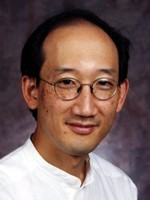- Undergraduate
- Graduate
- Research
- Algebraic and Arithmetic Geometry
- Applied Mathematics
- Computer Algebra
- Discrete Mathematics
- History of Mathematics
- Industrial Mathematics
- Mathematics, Genomics & Prediction in Infection & Evolution - MAGPIE
- Mathematics and Data
- Mathematics of Communications
- Number Theory
- Operations Research
- Centre for Operations Research and Decision Sciences
- PIMS at SFU
- Scientific Computing, Machine Learning and PDE
- People
- Math Internal Resources
- About Us
- Events | Outreach | News
- MATH EDI GROUP
- Grad Internal Resources
- Student Groups

David Muraki
Areas of interest
There is much interesting mathematics to be found by observing the world around us. One such simple question comes from watching the weather, "Why do low-pressure cells intensify much more than high-pressure cells?" We know that the answer is hidden within the complex model equations used for the computer weather forecasts, but a simpler explanation still defies meteorologists. It is the desire to understand physical reality using idealized models that motivates my interest in the mathematics of nonlinear partial differential equations (PDEs).
My own philosophy of mathematical inquiry follows the progression: idealization, analysis and interpretation. The first, idealization or modelling, obtains simple model equations that derive from natural laws and systematic approximations. The second, analysis and computation, seeks to understand these equations through construction of solutions and their properties. The last, interpretation, reassesses these mathematical results for their qualitative and quantitative value within the original physical context.
The common mathematical theme in my research is the development and application of asymptotic methods for nonlinear PDEs. These asymptotic techniques are used for simplifying model systems to allow further analysis or computation, or for constructing approximate solution algorithms for PDEs. Numerical computation plays an essential role in the investigation and verification of these asymptotic theories. These methods are then used as a basis for understanding the evolution and dynamics of nonlinear patterns and waves within PDE models.
Most recently, I have been investigating models from the field of geophysical fluid dynamics (GFD), a specialization to rotating and stratified fluids which applies to the motions of the atmosphere and oceans. Much of this work, pertaining to midlatitude (North American) weather, is in direct collaboration with meteorologists at the National Center for Atmospheric Research (NCAR, Boulder CO) and the Atmospheric Sciences Department at the University of Washington (Seattle WA). In addition to the above issue of pressure-cell asymmetry, we are also investigating the generation of atmospheric gravity waves in connection with clear-air turbulence, and the Influence of the tropopause (the lower boundary of the stratosphere) on the development of surface weather.
Education
- Ph.D. Applied Mathematics · Northwestern University · 1990
Research Areas
Courses
Fall 2024
Future courses may be subject to change.

